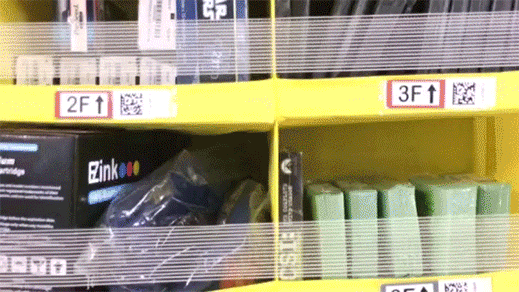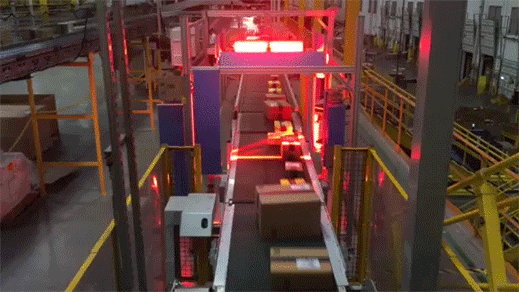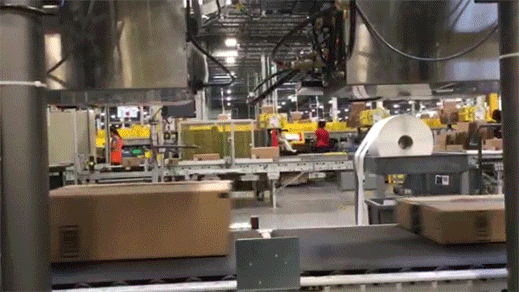Inside Amazon’s Warehouse, Human-Robot Symbiosis
Trenton, New Jersey, isn’t the industrial powerhouse it once was, even if the slogan “Trenton Makes, the World Takes,” first installed in 1935, still stands in 10-foot-tall letters across a bridge that spans the Delaware River to Pennsylvania. But a few minutes east of town, inside a warehouse belonging to Amazon, there are signs of another industrial transformation.

Amazon’s fulfillment center, located in the township of Robbinsville, is a dizzying hive of activity, with humans and machines working in carefully coördinated harmony. Besides showing the incredible efficiencies of Amazon’s operations, the factory hints at how, over the coming decades, technology may start to assist human workers with many simple manual tasks. How far this change goes, and how quickly it comes about, could make a significant difference to the labor market (see “Who Will Own the Robots?”).
At the center of the warehouse is a storage space containing square shelves packed with countless products from Amazon’s inventory. In previous generations of its fulfillment center, Amazon’s workers would have roamed these shelves searching for the products needed to fulfill each new order. Now the shelves themselves glide quickly across the floor carried atop robots about the size and shape of footstools. In a carefully choreographed dance, these robots either rearrange the shelves in neatly packed rows, or bring them over to human workers, who stack them with new products or retrieve goods for packaging.

Amazon’s robotic shelves allow more products to be packed into a tighter space. They also make stacking and picking more efficient by automatically bringing empty shelves over to packers or the right products over to pickers. The process is more efficient than having humans walk around, so it also a good example of how automation can be combined with human labor to increase productivity.
“They’re pretty quick and efficient,” says Emily Specca, who works on the picking line in the Robbinsville plant. But she says sometimes the robots malfunction, slowing her down, and she confesses that she’d probably quite like to be able to walk around once in a while.
For many decades, industrial robots were confined to performing extremely precise and repetitive tasks, and were separated from human workers. In recent years, however, thanks to better computer chips, algorithms, sensors, and actuators, robots have become cheaper, safer, and better able to learn new tasks quickly.

Amazon’s robots come from a company called Kiva Systems that it acquired in 2012. They are controlled by a central computer and navigate using markers on the ground. Amazon has begun exploring ways that it might someday automate some of the shelf-picking work at its factories (see “Help Wanted: Robot to Fulfill Amazon Orders”). However, robots are still incapable of tasks that require fine manipulation or improvisation, so it is useful to devise ways for robots to collaborate with humans more effectively.
“It’s a natural outgrowth of efforts to harness cheap computing power to make robots more collaborative,” says Wily Shih, a professor at Harvard Business School who studies manufacturing. Shih says the big hope is that robots will become “easier to drop into factory and distribution settings, and easier to integrate with existing manual processes and workers.”
While Amazon’s warehouse is designed around its robots, some companies hope to develop robots capable of working in regular warehouses. Fetch Robotics, based in San Jose, California, is developing a robot designed to retrieve products from shelves in a warehouse that was not designed for robots.
Amazon’s robots may indeed be just the first of many more collaborative robots. “I think everyone is experimenting with them now,” says Harvard’s Shih. “So you’ll see a whole range.”

But beyond robotic shelves, humans work in close collaboration with automation across Amazon’s warehouse. Products flow through the warehouse at a dizzying pace, tracked from arrival to dispatch by a computer system. At the start of the process, a sophisticated computer vision system recognizes products after they are unpacked.
On the other side of the warehouse, workers pack products into boxes for shipping with help from Amazon’s central computer systems. Items retrieved from storage shelves are automatically identified and sorted into batches destined for a single customer. The computer knows the dimensions of each product and will automatically allocate the right box, and even the right amount of packing tape. Further along, before products are sent to different trucks for dispatching, boxes are weighed to make sure no mistakes have been make in packing.
The importance of human-machine symbiosis, for the time being at least, isn’t lost on Amazon’s press relations team. “We like to think of it as a symphony of software, machine learning, computer algorithms, and people,” Amazon spokeswoman Kelly Cheeseman told me as we walked around. “And the people are such an important component; the technology wouldn’t mean anything if you didn’t have great employees that help interact and engage with it.”
Deep Dive
Artificial intelligence
Large language models can do jaw-dropping things. But nobody knows exactly why.
And that's a problem. Figuring it out is one of the biggest scientific puzzles of our time and a crucial step towards controlling more powerful future models.
Google DeepMind’s new generative model makes Super Mario–like games from scratch
Genie learns how to control games by watching hours and hours of video. It could help train next-gen robots too.
What’s next for generative video
OpenAI's Sora has raised the bar for AI moviemaking. Here are four things to bear in mind as we wrap our heads around what's coming.
Stay connected
Get the latest updates from
MIT Technology Review
Discover special offers, top stories, upcoming events, and more.